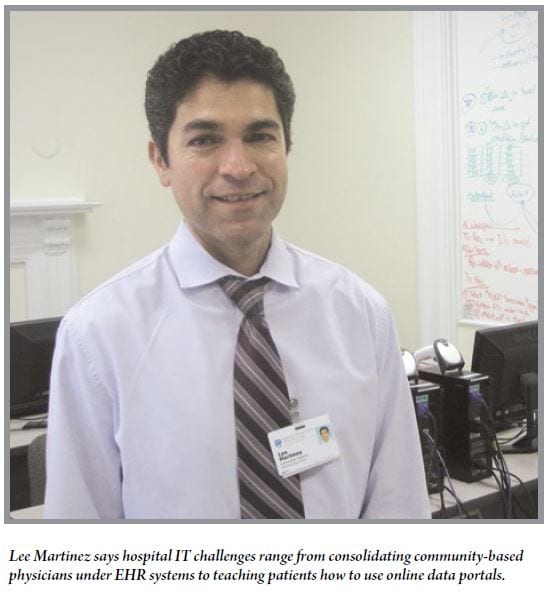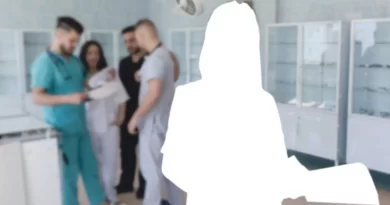The Big Disconnect – What’s Next for Electronic Health Records?
The goals of electronic health records are easily understood. The path to get there … well, that’s a bit thornier.
“The big push for us is still meaningful use and the sharing of data. That’s what everyone wants … to share information across the continuum,” said Carl Cameron, chief operating officer at Holyoke Medical Center, before offering an example of what an effective EHR system would accomplish.
“If your primary-care doctor sends you a referral to a specialist, they can share information back and forth. If you end up in the emergency room, the doctor can see the information about your last visit or past visits to the primary-care office. Historically, care has been episodic. Basically, if you have a sore throat or something else is wrong with you, you call the doctor’s office, they see you and document it, and nobody else may ever see that note.”

However, when the Centers for Medicare & Medicaid Services (CMS) created mandates in 2009 for hospitals and other providers to move toward EHR use (the term is used interchangeably with EMR, or electronic medical record), they didn’t anticipate the sheer number of different systems that would arise and the confusion they would engender. Today, well over 80{06cf2b9696b159f874511d23dbc893eb1ac83014175ed30550cfff22781411e5} of all physician practices in Massachusetts have established EHRs — for practices with more than 10 doctors, the figure is close to 100{06cf2b9696b159f874511d23dbc893eb1ac83014175ed30550cfff22781411e5} — but not without frustration, cost, and a large dose of uncertainty.
It’s not just a Massachusetts problem. Dr. Steven Stack, president of the American Medical Assoc., recently wrote an article in which he detailed cases like that of a Georgia physician in pulmonary critical care and sleep medicine who was an early adopter of EHR technology in 2006, more than three years before the legislation that mandated it and established the first deadlines.
She said her three-physician practice has spent $84,000 on EHR and related IT costs, yet she doesn’t plan to continue its use, preferring instead to take a financial penalty, because she’s so dissatisfied with the limitations of the system.
“Physicians are trying to use EHRs to improve patient care, investing a lot of time and money into making them work, but they are being thwarted,” Stack wrote. “The goal of the meaningful-use program was to encourage physician adoption of EHRs. This has been accomplished. Today, more than 80{06cf2b9696b159f874511d23dbc893eb1ac83014175ed30550cfff22781411e5} of physicians have implemented some form of EHR system. But we’re not getting what we expected from this technology.

“As physicians,” he went on, “we had hoped that these tools would help facilitate patient engagement, reduce administrative burdens, and promote the exchange of data. Those three things have definitely not happened. Instead, we’re dealing with systems that won’t talk to one another, cost too much to maintain, and require us to spend an inordinate amount of time entering data instead of helping patients.”
Delcie Bean, CEO of Paragus Strategic IT in Hadley, has heard similar frustrations. His firm got into the EHR consulting business several years ago — a ripe field, since doctors by 2011 and 2012 were hiring EHR vendors at a rapid pace. The pace has slowed down considerably, Bean said, largely because the practices that planned to adopt EHRs have done so, but also because of uncertainty about the technology’s end game.
“There seem to be some practices that, for one of a couple reasons, are hesitant to do it. First and foremost, there continues to be a huge consolidation of private practices by hospitals, and doctors are saying, ‘why spend all that time and money when, in a couple of years, we’ll be acquired by a hospital?’ It’s hard to answer that question,” he said, adding that many doctors don’t feel incentivized to adopt the technology until it becomes marketable or it becomes more clear whether they’ll be acquired or stay private.
“The second thing is, there has been a ton of consolidation at the EMR level, and a lot of providers are waiting to see which EMRs end up being the one their specialty or their region rallies around,” Bean continued, adding that the number of competing EMR systems has begun to shrink, from around 500 at its peak to about 400 today. “With so many players, doctors are waiting to see who’s going to end up on top before they invest. With such a huge investment of time and money, they’re afraid of getting it wrong. I don’t blame them.”
In the Beginning
EMRs represent a new and often-intimidating landscape for doctors. As recently as 2003, fewer than 5{06cf2b9696b159f874511d23dbc893eb1ac83014175ed30550cfff22781411e5} of the Commonwealth’s hospitals, and even fewer practices, used any sort of electronic record system, according to the Mass. Medical Society (MMS).
But in 2009, as part of the American Reinvestment and Recovery Act (ARRA), the federal government included a section called Health Information Technology for Economic and Clinical Health, or HITECH, with the goal of improving patient care through federal investment in IT infrastructure and — crucially — adoption of electronic health records capable of interoperability, privacy, and security.
Included in ARRA — otherwise known as the federal stimulus bill — were provisions for incentives of at least $44,000 per physician for meaningful use of an EHR. Reimbursement would be issued through Medicare and Medicaid after proof of regular EHR use in more than 20 areas, including computerized order entry, e-prescribing, recording demographics, medication lists, allergies, vital signs, smoking status, and several clinical measures.
At the heart of this process is the term ‘meaningful use,’ which is essentially using EHR technology to improve healthcare quality, safety, and efficiency; engage patients and families more directly in their care; improve care coordination between providers; improve population and public health; and maintain privacy and security of patient information.
Stage 1 of meaningful use, the explosion of activity in 2011 and 2012 that Bean referred to, concentrated on data capture and sharing. The goal of stage 2, which CMS expected to be complete by this year, focused on advancing clinical processes, such as more rigorous health-information exchanges, stricter requirements for e-prescribing and lab results, electronic transmission of patient-care data across multiple settings, and more patient-controlled data.
The problem is that many providers need more time to achieve the goals of stage 2 meaningful use, and won’t realistically approach the requirements for stage 3 by the 2017 deadline; these include improving quality, safety, efficiency, and health outcomes; patient access to self-management tools; and documented improvements in population health through EHRs, just to name a few.
“I think it’s a huge challenge, and it’s draining the resources that many providers need to put into this, whether it’s dollars or staff or upgrading applications or hardware — all those things enter into the picture,” MMS President Dr. Dennis Dimitri told HCN. “And even though the EHRs have to be certified to allow physicians to use them and qualify for the incentive payment, it doesn’t mean the EHR allows you to easily do all the tasks of stage 2 and eventually stage 3.
“Anecdotally, I know more than one physician who’s said, ‘it’s too hard to work, too time-consuming, and it’s interfering with my ability to take care of my patients; I’m not going to qualify for stage-2 meaningful use,’” he went on. “And with the potential for financial penalties from CMS, physicians are just putting their hands up and saying, ‘I can’t do it.’”
That’s why medical societies across the country are pushing for changes in the timelines for meaningful use stage 2 and 3, he added. “Physicians bought in; they thought it was the right thing to do. And now they’re finding out these systems are not living up to the promise.”
Theoretically, EHRs should improve practice efficiency. By replacing paper records with electronic data, the thought went, practices could reduce record handling and access data more quickly for clinical, workflow, and billing purposes. EHRs are also intended to improve quality of care, reduce prescribing and treatment errors, and prepare practices for the collaborative world of accountable care.
But, in reality, the MMS reports, doctors are complaining that inputting data electronically actually takes up more time than written records, system outages are persistent, technical support from vendors can be unreliable, and — perhaps most significantly — interoperability and transportability of data from one EHR brand to another is not yet common, and changing brands can be costly, time-consuming, and stressful.
“Electronic medical records have added to the amount of time physicians spend entering data, which increases their workload. Most physicians will tell you their day is longer by using EMRs, not shorter,” Dimitri told HCN. “They also worry that an electronic medical record gets between them and the patient, when the physician is spending a lot of time looking at the medical record, filling in information, checking boxes. There has been some concern that may have a negative impact on the patient-physician relationship.”
Cameron agreed. “Providers have to change the way they interact with patients, and that’s not always easy because now they’re talking with the patient with a laptop between them, looking at the record. Certainly, that’s a challenge.”
Come Together
As for interoperability of EHR systems, the industry is seeing improvement, if only due to consolidation. In fact, according to the MMS, 80{06cf2b9696b159f874511d23dbc893eb1ac83014175ed30550cfff22781411e5} of Massachusetts practices are using one of seven large EHR vendors.
“People wanted to get away from this ad hoc system of 20 EMRs in the community,” said Lee Martinez, chief information officer at Cooley Dickinson Hospital. So CDH, for its part, is moving to Epic, one of those seven vendors, and is slowly bringing its affiliated physician practices on board.
However, Bean said, interoperability remains a big question mark for many practice administrators grappling with EHR adoption. “Doctors know this will help their practice ultimately, but there are so many questions about interoperability, referrals, how patients access their records — a lot of uncertainty and unknowns. And whenever there’s uncertainty, people stay on the fence about it.”
Meanwhile, Holyoke Medical System has about 80 doctors in its health-information exchange, which uses the eClinicalWorks system.
“We’re working very hard to put all these initiatives in place and make sure we provide good-quality patient care,” Cameron said. “We’re in the process now of implementing a product called Qpid, which is essentially like a Google for healthcare. Basically, it sits on top of your medical record and becomes a search engine to help us do surveillance on a behavioral-health patient or cardiac patient, for example; when the patient presents in the emergency room, it will give the clinician a dashboard of past information so they don’t have to search the entire medical record.
“We believe that snapshot provides a higher level of care for the patient,” he went on, “helping clinicians make real-time decisions in the emergency room. Eventually, we’re going to tie that into the health-information exchange … we see this as a very powerful tool.”
The next piece, Cameron said, is applying EHR systems to population health, in terms of managing, say, the region’s diebetic population or COPD population, with the goal of reducing rehospitalization.
“That’s the big focus — keeping them out of the emergency room and, if they do show up, making sure they don’t come back within 30 days, because Medicare and others are starting to penalize hospitals for patients [returning to] the emergency room,” he explained. “We’ll have patient-care navigators with access to patients’ information, so if they have chronic diseases such as diabetes, follow up with them, make sure they’re keeping their appointment to see their specialist, make sure they’re taking their medications. This will help reduce the overall healthcare costs of those patients.”
Another component to population health is teaching patients how to use electronic portals, secure websites where they can access their personal health information.
“We have a patient portal and a physician portal here at Cooley Dickinson,” Martinez said. “I think that’s one big promise for the near term — getting patients more involved in this. In our community, a lot of patients are using the portal to manage their own care. We think that’s extremely important.”
Understanding the broad promise of EHRs but also recognizing the current challenges, both the AMA and the MMS are advocating for a pause in stage 3 mandates until all practices can reach stage 2. For its part, the Centers for Medicare and Medicaid Services (CMS) recently issued some final and proposed regulations for stages 2 and 3 of meaningful use (see story, page 33).
Dimitri recently testified before the state Legislature’s Joint Committee on Health Care Financing in support of a bill that would provide additional time for healthcare providers to comply with the interoperable EHR mandate contained in the 2012 healthcare cost-containment bill, Chapter 224.
“While the medical society continues to study and encourage adoption of interoperable medical records where appropriate,” he told lawmakers, “legislative mandates carrying financial penalties are not the appropriate policy level to promote this practice.”
Brave New World
Speaking with HCN, Dimitri said the state’s physicians are not shrinking away from the future, but rather embracing it.
“I think physicians have been excited about the potential of electronic medical records for some time. A few early adopters have been doing some kind of electronic medical record for well over a decade. A larger number of physicians didn’t have full electronic medical records, but had been electronically prescribing for some period of time — again, going back well over a decade.
“Since then,” he went on, “the speed with which electronic medical records have been adopted in physician practices has picked up so much that in excess of 80{06cf2b9696b159f874511d23dbc893eb1ac83014175ed30550cfff22781411e5} of physician practices now have an electronic medical record. So, from my perspective, physicians have been very interested in this technology and have high hopes about what it can do for them. The bad news is, electronic medical records have not been the panacea that many of us hoped they would, improving the ability to collect and share data and extract information about patients and population health.”
Time will tell whether EHRs flourish and reach their intended goals, but HMC’s Cameron feels the promise is worth the effort.
“There are a lot of challenges right now,” he said, “but I still believe technology should be a part of revolutionizing healthcare.”





Comments are closed.